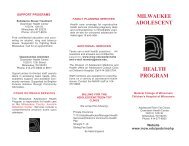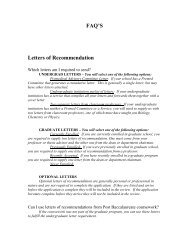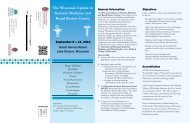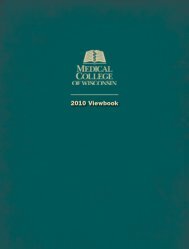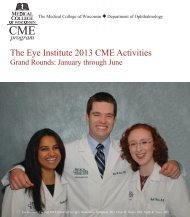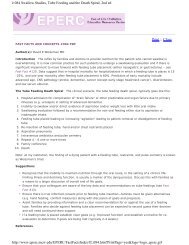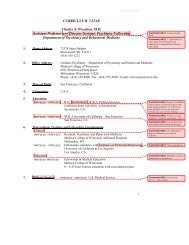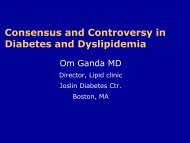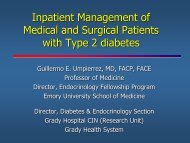Overview of Therapies
Overview of Therapies
Overview of Therapies
You also want an ePaper? Increase the reach of your titles
YUMPU automatically turns print PDFs into web optimized ePapers that Google loves.
Liraglutide Safety and Tolerability• Safety across 5 clinical trials (monotherapy and combination therapy)– Withdrawals due to AEs• 7.8% for liraglutide versus 3.4% for comparators• Difference driven by GI events– GI events: 41% for liraglutide versus 17% for comparators– Common AEs a : headache, nausea, diarrhea, antibody formation• Hypoglycemia– Severe hypoglycemia in 7 liraglutide patients, all on SU or with otherlikely cause– Highest incidence <strong>of</strong> minor hypoglycemia as add-on to metformin andglimepiride (liraglutide, 27.4%; PBO, 16.7%; insulin, 28.9%)• Renal impairment: no dose adjustment required, but experience in thispopulation is limitedAEs, adverse event; GI, gastrointestinal.a ≥5% <strong>of</strong> liraglutide-treated patients andVictoza (liraglutide) [prescribing information].more common than with placebo.http://www.accessdata.fda.gov/drugsatfda_docs/label/2010/022341lbl.pdf.Nausea Management WithGLP-1 Receptor Agonists• Titrate dose• For exenatide, inject closer to mealtime• Keep track <strong>of</strong> foods that cause nausea• Eat smaller portions• Reduce fat content <strong>of</strong> meal• Nausea remedies– Foods: ginger, sugar-free mints, soda crackers,rice crackers, hot water sipped slowly– Other: deep breaths, long walksNausea With Liraglutide and ExenatideDecreases Over TimeProportion<strong>of</strong> Subjects (%)20181614121086420a With MET and/or SU.LIRA 1.8 mg daily a (n = 233) EXN 10 mcg twice daily a (n = 231)0 2 4 6 8 10 12 14 16 18 20 22 24 26Time (wk)• Nausea is lower for longer-acting liraglutide than for exenatide twice daily.• Patients also experience less nausea with exenatide LAR than exenatide twice daily.Buse JB, et al. Lancet. 2009;374:39-47.Drucker DJ, et al. Lancet. 2008;372:1240-1250.Incretin-based <strong>Therapies</strong>:Reduced Risk <strong>of</strong> Hypoglycemia• Insulinotropic activity <strong>of</strong> GLP-1 is glucosedependent– Secretion <strong>of</strong> GLP-1 correlates with glucose level andinsulin secretion– Insulinotropic effects occur at increased circulatingglucose concentrations, disappear at normal plasmaglucose levels• GLP-1 suppression <strong>of</strong> glucagon secretion isglucose-dependent– Inhibitory effect on glucagon secretion is lost belownormal fasting glucose levels– Reduction in plasma glucagon levels contributes toless reduction in hepatic glucose outputKim W. Pharmacol Rev. 2008;60:470-512.Exenatide:Risk <strong>of</strong> Hypoglycemia (Mild-Moderate)Inciden nce (%)4030201003+ SU(N=377) 13614 135 5 5+ MET(N=336) 230-week RCTs1. Buse JB et al. Diabetes Care. 2004;27:2628-2635; 2. DeFronzo RA et al. Diabetes Care. 2005;28:1092-1100;3. Kendall DM et al. Diabetes Care. 2005;28:1083-1091; 4. Zinman B et al. Ann Intern Med. 2007;146:477-485.1928+ MET + SU(N=733) 3711+ TZD ± SU(N=233) 416-week RCTPlaceboExenatide 5 μg bidExenatide 10 μg bidIncidence (%)Liraglutide Effects and Action in Diabetes(LEAD) Program: Risk <strong>of</strong> Minor Hypoglycemia35302520151050Liraglutide 1.8 mg Rosiglitazone Glimepiride Insulin glargine Placebo ExenatideLEAD-1 1 LEAD-2 2 LEAD-4 3LEAD-5 4 LEAD-6 5Add-on to SU Add-on to MET Add-on to MET + TZD Add-on to MET + SU Add-on to MET ± SU(N=1041)(N=1091)(N=533)(N=581)(N=464)Baseline A1C: 8.4% Baseline A1C: 8.4% Baseline A1C: 8.6% Baseline A1C: 8.3% Baseline A1C: 8.2%84173 3 326-week trials.1. Marre M et al. Diabet Med. 2009;26:268-278; 2. Nauck M et al. Diabetes Care. 2009;32:84-90; 3. Zinman B et al. Diabetes Care.2009;32:1224-1230; 4. Russell-Jones D et al. Diabetologia. 2009;53:2046-2055; 5. Buse JB et al. Lancet. 2009;374:39-47.85272916.72634Cardiovascular Safety:GLP-1 Receptor AgonistsExenatide• Meta-analysis <strong>of</strong> clinical trials for exenatidetwice daily– No increased risk <strong>of</strong> CV events– Relative risk (95% CI) = 0.69 (0.46, 1.04) vs pooled comparatorLiraglutide• US FDA analyses <strong>of</strong> clinical trial dataidentified no excess risk <strong>of</strong> CV events versuscomparators (active or placebo)Shen L, et al. Diabetes. 2009;58(suppl 1):366-OR;FDA briefing materials – liraglutide. http://www.fda.gov/ohrms/dockets/ac/09/briefing/2009-4422b2-01-FDA.pdf; Update on FDA Advisory Committee meeting onliraglutide for the treatment <strong>of</strong> type 2 diabetes. http://www.novonordisk.com/include/asp/exe_news_attachment.pdf?sAttachmentGUID=1c87137d-806f-41bc-832a-e5a74aa86164.Pancreatitis With Incretin-Based<strong>Therapies</strong>: Large Database Analysis• Cases <strong>of</strong> pancreatitis with exenatide, liraglutide and the DPP-4 inhibitor sitagliptin have led to addition <strong>of</strong>label warnings/precautions• Large US commercial health insurance database analysis revealed no increased risk for exenatide orsitagliptin compared with metformin or glyburidePancreatitis occurrence0.13% <strong>of</strong> exenatide-treated treated patients0.12% <strong>of</strong> sitagliptin-treated patientsEXN, exenatide; GLY, glyburide;MET, metformin; SITA, sitagliptin.0.0 0.5 1.0 1.5 2.0 2.5Relative Risk (95% confidence interval)EXN (n = 27,996) vsMET or GLY (n = 27,983)SITA (n = 16,267) vsMET or GLY (n = 16,281)Byetta (exenatide) [prescribing information]. http://pi.lilly.com/us/byetta-pi.pdf.Victoza (liraglutide) [prescribing information].http://www.accessdata.fda.gov/drugsatfda_docs/label/2010/022341lbl.pdf.Januvia (sitagliptin) [prescribing information].http://www.merck.com/product/usa/pi_circulars/j/januvia/januvia_pi.pdf.Dore DD, et al. Curr Med Res Opin. 2009;25:1019-1027.Exenatide and Thyroid Tumors• Animal studies: Thyroid C-cell tumorsobserved in rodent models• Clinical trials– No thyroid cancer in clinical i l trials– Small, similar decreases in calcitonin levels reported forexenatide and liraglutide in head-to-head trial• Postmarketing experience– 3 cases <strong>of</strong> papillary thyroid cancer– 6 cases <strong>of</strong> unspecified thyroid cancerFDA briefing materials – liraglutide. http://www.fda.gov/ohrms/dockets/ac/09/briefing/2009-4422b2-01-FDA.pdf.Buse JB, et al. Lancet. 2009;374:39-47.3
Liraglutide and Thyroid Tumors• Animal studies: Thyroid C-cell tumors observedin rodent models• Clinical trials– Thyroid C-cell hyperplasia: 5 cases with liraglutide vs 1 case withcomparators– Medullary thyroid carcinoma: 1 case in a comparator-treated treated patient– Calcitonin levels• Mean concentrations higher for liraglutide vs placebo• Mean concentrations not higher for liraglutide vs activecomparators• Small, similar decreases in calcitonin levels reported forexenatide and liraglutide in head-to-head trial• Label information– Relationship between tumors in animals and risk to humans is unclear– Counsel patients regarding risks and symptoms <strong>of</strong> thyroid tumorsClinical Trial Evidence forDPP-4 Inhibitors-Glycemic Effects-Side Effects-SafetyInhibition <strong>of</strong> DPP-4 to IncreaseActive GLP-1Mixed mealIntestinalGLP-1releaseAcute GLP-1 Actions• Augments glucose-induced insulinsecretion• Inhibits glucagonsecretion and HGP• Slows gastric emptying• Enhances satiety• Increases glucose disposalGLP-1 (7-36)ActiveLonger-Term GLP-1 Actions• Increases insulin biosynthesis• Promotes β-cell differentiationDPP-4InhibitorDPP-4GLP-1 (9-36)FDA briefing materials – liraglutide. http://www.fda.gov/ohrms/dockets/ac/09/briefing/2009-4422b2-01-FDA.pdf; Buse JB, et al. Lancet.2009;374:39-47; Victoza (liraglutide) [prescribing information]. http://www.accessdata.fda.gov/drugsatfda_docs/label/2010/022341lbl.pdf.Drucker DJ. Diabetes Care. 2003;26:2929-2940.Sitagliptin:A1C Effects as Add-On Therapyb,cStudyΔ A1C (%)Sitagliptin a Δ A1C (%)Sitagliptin +CharacteristicsComparator(s)N = 1050, 24 weeks– –0.4 b MET: –0.6Baseline A1C = 7.2%N = 1172, 52 weeksMetformin –0.7 b GLIP: –0.7Baseline A1C = 7.5%PBO: –0.2N = 273, 18 weeksBaseline A1C = 7.7%Metformin –0.7 07RSG: –0.8N = 353, 24 weeksBaseline A1C = 8.1% d Pioglitazone –0.9c PBO: –0.2N = 441, 24 weeks Glimepiride +–0.6 c PBO: 0.3Baseline A1C = 8.3% metformin• A1C decreased 8.5% to 6.9% over 104 weeks in pooled analysis <strong>of</strong> monotherapy and metformin add-on trials.GLIP, glipizide.a 100 mg once daily; b Noninferior ornot different vs active comparator; c P≤ .001 vs PBO; d Sitagliptin group.Aschner P, et al. Diabetes Obes Metab. 2009 Nov 25 [Epub ahead <strong>of</strong> print];Nauck MA, et al. Diabetes Obes Metab. 2007;9:194-205; Scott R, et al.Diabetes Obes Metab. 2008:10:959-969; Rosenstock J, et al. Clin Ther.2006;28:1556-1568; Hermansen K, et al. Diabetes Obes Metab. 2007;9:733-745; Williams-Herman DE, et al. Diabetes. 2009;58(suppl 1):540-P.StudyCharacteristicsN = 401, 24 weeksBaseline A1C = 7.9%N = 743, 24 weeksBaseline A1C = 8.0%N = 565, 24 weeksBaseline A1C ≈ 8.3%N = 768, 24 weeksBaseline A1C ≈ 8.4%a P ≤ .001 vs PBO.b Rosiglitazone or pioglitazone.Saxagliptin: A1C Effects asAdd-On TherapySaxagliptin +–MetforminThiazolidinedione bGlyburideΔ A1C (%)SaxagliptinΔ A1C (%)Comparator(s)2.5 mg: –0.4 a5.0 mg: –0.5 a PBO: 0.225mg:–0 2.5 0.6aPBO: 0.15.0 mg: –0.7 a2.5 mg: –0.7 a5.0 mg: –0.9 a PBO: –0.32.5 mg: –0.5 a5.0 mg: –0.6 a PBO: 0.1Rosenstock J, et al. Curr Med Res Opin. 2009;25:2401-2411; DeFronzo RA, et al.Diabetes Care. 2009;32:1649-1655; Hollander P, et al. J Clin Endocrinol Metab.2009;94:4810-4819; Chacra R, et al. Int J Clin Pract. 2009;63:1395-1406.Therapeutic Effects <strong>of</strong> DPP-4InhibitorsParameter Sitagliptin Saxagliptin Alogliptin VildagliptinAverage A1C reduction (%) 0.6-0.9Weight change (kg)Common adverse eventsWeight neutralHeadache, nasopharyngitis, urinary tractinfection, upper respiratory infectionJanuvia (sitagliptin) [prescribing information]. http://www.merck.com/product/usa/pi_circulars/j/januvia/januvia_pi.pdf.Onglyza (saxagliptin) [prescribing information].http://packageinserts.bms.com/pi/pi_onglyza.pdf.DeFronzo R, et al. Diabetes Care. 2008;31:2315-2317.Amori RE, et al. JAMA. 2007;298:194-206.Sitagliptin Clinical Safety andTolerability• Pooled analysis <strong>of</strong> 12 clinical trials– Similar for sitagliptin versus placebo and active comparatorgroups: overall AEs, serious AEs, discontinuations due to AEs,cardiac- and ischemia-related experiences, laboratory AEs– Drug-related AEs and discontinuations due to drug-related AEs• Lower for sitagliptin ti versus placebo and active comparator groups• Primarily due to lower incidence <strong>of</strong> hypoglycemia• Label information– May need lower SU dose in combination with sitagliptin toreduce hypoglycemia risk– Dose adjustment recommended for patients with moderate orsevere renal insufficiency or ESRDWilliams-Herman D, et al. BMC Endocr Disord. 2008;8:14. http://www.biomedcentral.com/1472-6823/8/14; Januvia(sitagliptin) [prescribing information]. http://www.merck.com/product/usa/pi_circulars/j/januvia/januvia_pi.pdf.AE, adverse event.Saxagliptin Clinical Safety andTolerability• Pooled analyses <strong>of</strong> clinical trial data– Common AEs a : URTI, UTI, headache– Hypoglycemia: comparable across groups, no events requiring medicalassistance– Hypersensitivity b : 1.5% <strong>of</strong> saxagliptin-treated and 0.4% <strong>of</strong> placebotreatedpatients, no hospitalizations or life-threatening events– Decreased lymphocyte count: clinical significance unknown• Prescribing information– Dose adjustments recommended• Moderate or severe renal impairment or ESRD• Patients taking strong cytochrome P450 3A4/5 (CYP3A45/5) inhibitors– Lower dose <strong>of</strong> secretagogue may be needed to avoid hypoglycemia incombination with saxagliptin– Peripheral edema more common when combined with TZDa Onglyza (saxagliptin) [prescribing information].Occuring in ≥ 5% <strong>of</strong> patients treated with 5 mg saxagliptin and morehttp://packageinserts.bms.com/pi/pi_onglyza.pdf.commonly than in placebo groups; b urticaria, facial edemaChen R, et al. Diabetes. 2009;58(suppl 1):2082-PO.DPP-4 Inhibitors:Weight, Lipids and Blood Pressure• Sitagliptin clinical trial results– No significant change in bodyweight exceptsignificant decrease vs. increase for glipizide– Lipid neutral (where noted)– No clinically meaningful changes in vital signs• Saxagliptin clinical trial results– No significant changes in bodyweight vs. PBO– No significant changes in fasting lipids vs. PBO– No clinically meaningful changes in vital signsJanuvia [sitagliptin] prescribing information. http://www.merck.com/product/usa/pi_circulars/j/januvia/januvia_pi.pdf.Onglyza [saxagliptin] prescribing information. http://packageinserts.bms.com/pi/pi_onglyza.pdf.4
Hypoglycemia Risk With DPP-4Inhibitors• SitagliptinLower for sitagliptin versus comparator groups• 3.4% for sitagliptin (monotherapy or as add-on to oral agents, includingSUs)• 10.9% for comparators (placebo or oral agents, including SUs)• Saxagliptin– Lower or comparable for saxagliptin vs comparator groups• 1.5% to 8.8% for saxagliptin (monotherapy, initial combination withmetformin or add-on to MET, SU or TZD)• 4.1% to 6.8% for comparators (placebo or metformin)– No events required medical assistance• For both, in combination with a secretagogue, a lower secretagogue dose maybe required to reduce hypoglycemia riskWilliams-Herman, et al. BMC Endocr Disord. 2008 Oct 7;8:14; Chen R, et al. Diabetes. 2009;58(suppl 1):2082-PO; Onglyza [saxagliptin] prescribing information.http://packageinserts.bms.com/pi/pi_onglyza.pdf;Januvia [sitagliptin] prescribing information. http://www.merck.com/product/usa/pi_circulars/j/januvia/januvia_pi.pdfCardiovascular Safety inSaxagliptin Clinical TrialsData from 8 randomized, double-blind, phase 2b/3 trials aMajor adverse cardiovascular events (MACE) bAcute cardiovascular events (ACE) c0.44Saxagliptin Comparator(0.24, 0.82)Event type n (%)n (%)MACEACE 38 (1.1) 23 (1.8)MACE 23 (0.7) 18 (1.4)All deaths 10 (0.3) 12 (1.0)ACE0.59CV deaths 7 (0.2) 10 (0.8)(0.35, 1.00)0 0.5 1 1.5 2Cox Proportional Hazard Ratio(95% confidence interval)a Saxagliptin exposure: n = 3356 (3758 patient-years);comparator exposure: n = 1251 (1293 patient-years).b Stroke, myocardial infarction, cardiovascular death.c Includes revascularization.Wolf R, et al. ADA 69th Scientific Sessions.Late Breaking Abstract Handout. 2009;8-LB:LB3.Summary• Incretin-based therapies address important underlying defects in thedevelopment & progression <strong>of</strong> T2DM• DPP-4 inhibitors and GLP-1 agonists are effective treatments andhave favorable safety pr<strong>of</strong>iles• The pleiotropic effects <strong>of</strong> incretin-based therapy make this anincreasingly important therapeutic class• Early use <strong>of</strong> these agents, especially in combination, would appearto <strong>of</strong>fer the most beneficial long-term benefits• Data generated to date suggest that the beneficial effects on thebeta cells may facilitate slowed progression <strong>of</strong> T2D• Effects on the CV system may inhibit vascular complicationsAmylin the Hormone• 37-amino acid peptide-discovered 1987• Colocated and cosecreted with insulinfrom pancreatic β cells• Deficient in diabetesAmylinInsulinUnger RH, et al. Williams Textbook <strong>of</strong> Endocrinology. 8th ed. 1992;1273-1275.Photographs reprinted with permission <strong>of</strong> Elsevier.Pramlintide• Synthetic analog <strong>of</strong> the β-cell hormone, amylin• Pramlintide limits postprandial glucoseexcursions through at least 3 mechanisms <strong>of</strong>action– Slows gastric emptying– Decreases postprandial hypersecretion <strong>of</strong>glucagon– Increases satiety, leading to decreased caloricintake and potential weight lossKong M-F, et al. Diabetologia. 1998;41:577-583; Fineman M, et al. Horm Metab Res. 2002;34:504-508;Chapman I, et al. Diabetologia. 2005;48:838-848; Kruger DF, et al. Drugs. 2004;64:1419-1432Pramlintide Lowers A1C and Weight in SubjectsWith Type 2 Diabetes on Basal InsulinMean (+/-SE E) ∆ A1C (%)-0.0-0.2-0.4-0.6-0.8*Placebo-0.36 ± -0.08%-0.7 ± -0.11%-1.00 4 8 12 16Time (weeks)*P
AleglitazarAleglitazarAlglitazar: Statistically Significant Increases inAtheroprotective HDL CholesterolSource Linc<strong>of</strong>f AM, Henry R et al. Poster presented atACC 2009Source Linc<strong>of</strong>f AM, Henry R et al. Poster presented atACC 2009P values vs. placeboP values vs. placeboSource Linc<strong>of</strong>f AM, Henry R et al. Poster presented atACC 2009Source Linc<strong>of</strong>f AM, Henry R et al. Poster presented atACC 2009P values vs. placeboP values vs. placeboP values vs. placeboSource Linc<strong>of</strong>f AM, Henry R et al. Poster presented at ACC 2009SGLT2 Receptor Blockers:Novel Therapy for Type 2 DiabetesNormal Renal Glucose Handling• ≈ 180 g <strong>of</strong> glucose is filtered each day• Virtually all glucose reabsorbed in theproximal tubules & reenters the circulation• SGLT2 reabsorbs ≈ 90% <strong>of</strong> the glucose• SGLT1 reabsorbs ≈ 10% <strong>of</strong> the glucose• Virtually no glucose excreted in urineRenal Handling <strong>of</strong> Glucose in a Non-Diabetic IndividualGlucoseSGLT2S1 segment <strong>of</strong>proximal tubuleSG~90% LReabsorptionT1~10%Distal S2 / S3segment <strong>of</strong>proximal tubuleNO GLUCOSECollectingductWright EM. Am J Physiol Renal Physiol. 2001;280:F10-F18.Wright EM. Am J Physiol Renal Physiol. 2001;280:F10-F18. Thorens B. Am J Physiol. 1996;270:G541-G553.Na+ and Glucose at1:1 stoichiometrySGLT2 Mediates GlucoseReabsorption in the KidneyNa+GlucoseLumenSGLT2GlucoseS1 ProximalTubuleGLUT2BloodNa + K+Na+ATPaseGlucoseAdapted from Dr. Robert Henry, New Classes <strong>of</strong> Pharmacologic Agents for the Treatment <strong>of</strong> Hyperglycemiaon the Horizon: Sodium Glucose Cotransporter (SGLT) - Type 2 Inhibitors, Feb 2009.SGLT2 Inhibitors: A PotentialSolution?• Inhibition <strong>of</strong> SGLT2-mediated glucose reabsorption in therenal proximal tubule leads to increased glycosuria• Results in: reduced plasma glucose levels, enhancedinsulin sensitivity, suppressed hepatic glucoseproduction, and improved insulin secretion• Mechanism <strong>of</strong> action is independent <strong>of</strong> insulin resistanceor the severity <strong>of</strong> beta-cell dysfunctionDapagliflozin Phase 2b Study• 389 drug-naïve T2DM pts (348 completed) in a randomized,prospective, double-blind, placebo-controlled study• 18-79 years, A1c >7 and
)Effect <strong>of</strong> Dapagliflozin for 12Weeks on A1C in Type 2 DiabetesDapagliflozin Treatment Results inModerate GlucosuriaDapagliflozin Treatment IsAssociated With Weight LossA1C Change (%)DAPA 2.5 DAPA 5 DAPA 10 DAPA 50 PBO MET XR1500Baseline A1C (%) 7.7 8.0 8.0 7.8 7.9 7.70-0.2-0.4-0.6-0.8 P
Baseline (kg),mean (SD)Dapagliflozin Add-on to Metformin:Body Weight at Week 24 (LOCF)Percent changefrom baseline (%),adjusted mean(SE)Adjustedproportion <strong>of</strong>patients with ≥5%decreasefrom baseline,% (95% CI)Placebo +metformin(n=137)87.7± 19.2-1.02± 0.295.9(1.9, 9.8)Dapagliflozin2.5 mg +metformin(n=137)84.9± 17.8-2.66± 0.2824.0(16.8, 31.2)Bailey CJ, et al. Diabetologia. 2009 Vol. 52, (Suppl 1): S76Dapagliflozin5 mg +metformin(n=137)84.7± 16.3-3.66± 0.2825.4(18.1, 32.7)Dapagliflozin10 mg +metformin(n=135)86.3± 17.5-3.43± 0.2828.0(20.4, 35.5)Dapagliflozin Add-on to Metformin:Safety Data• No clinically meaningful changes in markers for renal impairment or increasesin mean serum creatinine• Similar proportion <strong>of</strong> patients across all treatment groups had blood pressuremeasurements suggestive <strong>of</strong> orthostatic hypotension but without symptoms• Reports <strong>of</strong> hypoglycemia were similar across all treatment groups and none ledto study discontinuation• Adverse events <strong>of</strong> special interest:Dapagliflozin Dapagliflozin DapagliflozinPlacebo2.5 mg + 5 mg + 10 mg ++ metforminmetformin metformin metformin(n=137)(n=137) (n=137) (n=135)Urinary tract8.0 4.4 7.3 8.1infections, %Genital infections, % 5.1 8.0 13.1 8.9Hypoglycemia, % 2.9 2.2 3.6 3.7Bailey CJ, et al. Diabetologia. 2009 Vol. 52, (Suppl 1): S76Dapagliflozin Add-on to Metformin:Conclusion• In patients with T2DM inadequatelycontrolled with metformin alone, addition <strong>of</strong>once-daily dapagliflozin appeared safe andwas associated with improved glycemiccontrol and clinically meaningful weight lossover 24 weeks compared to placebo +metforminBailey CJ, et al. Diabetologia. 2009 Vol. 52, (Suppl 1): S76Perspectives on SGLT2 InhibitionSummary <strong>of</strong> SGLT2 Inhibitors• Concerns• Polyuria• Electrolytedisturbances• Bacterial urinarytract infections• Fungal genitalinfections• Unexpected effects• Potential advantages• Weight loss(75g urine glucose =300kcal/day)• Low risk <strong>of</strong>hypoglycemia• Blood pressurelowering?• Effect independent <strong>of</strong>insulin• Reduce both preprandial and postprandial blood glucoseand HbA1c• May decrease glucotoxicity and consequently lead tosustained, long-term glycemic control• May have broad indications, including potentially forprevention <strong>of</strong> diabetes, obesity, and both T1DM andT2DM• Further studies in large numbers <strong>of</strong> human subjects willbe needed to determine how best to utilize these agentsin the treatment <strong>of</strong> diabetes8




